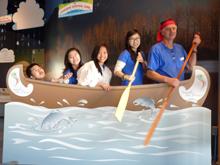



VIRTUAL CONTAINER SHIP SIMULATOR
BASED ON OUR “JOURNEY THROUGH THE WORKING RIVER” EXHIBIT
CONTROLS: Using your mouse, left-click and hold to drag the containers onto the freighter. You will need to lift the containers on either side of the boat. You win when you manage to put all the containers on the ship and make it balance perfectly. GOOD LUCK!
Want to learn more about the Exports that pass through the Fraser River? Click the arrow:
Most exports shipped out of BC’s ports are placed on boats bound for Asian countries like India, South Korea, China, and Japan.
Petroleum – This fossil fuel is pumped from below the Earth’s surface and is processed into fuels for cars and airplanes, as well as oils for machines. Most of it comes from Alberta and is sent to be refined in China or India.
Grain – Small dry seeds are a staple crop for many cultures. These grains include oats and lentils. They are either sent westward, towards our Asian trade partners, or south, to places like Mexico or Peru.
Canola – This is a type of flower that is grown in the prairies of Canada. Travelling across Alberta, Saskatchewan, and Manitoba, you will often pass endless fields of the yellow flowers. It is processed and turned into cooking oil. Most of it is exported to China.
Wood – If you are on the Fraser River, you have probably seen booms of logs being pulled by a tugboat. Booms are stored in the freshwater of the river, which also prevents shipworms from damaging the logs. Wood is used to make many products, from paper to fences to cooking utensils. Wood chips and pellets are a major export. They are used for heating, barbequing, and even can be found in some playgrounds. Most wood is sent from Vancouver to Japan and China.
Sulphur – This smelly element can be found in oilsands and is often used in fertilizers, as well as for bleaching paper. This is transported from the Athabasca Oil Sands in Alberta, where it is mined. From our ports, sulphur is sent to China, Australia, and New Zealand.
Barley – This grain is used as animal feed, as well as for making soups, stews, and some types of bread. It is grown in Saskatchewan, Manitoba, and in the border area between Alberta and British Columbia. Canadian barley is used mostly for animal feed and is sent to China and Japan.
Fertilizer – Fertilizer is made from decaying organic materials, such as plant trimmings and food waste. Fertilizers are used by many farmers to help their plants grow. From Vancouver ports, fertilizer is sent to countries like India.
Flax – This crop, grown mostly in Saskatchewan, is used to a variety of purposes. It is used for food, both for humans and animals. It is also made into fabric. Flax is exported to the US, Europe, and Japan.
Wheat – A type of grass, this crop is harvested and turned into flour, which is then baked into a vast variety of products. Different parts of the wheat are made into distinct types of flour, which are used in many countries, including China, Japan, Bangladesh, and South Korea.
Want to learn more about the Imports that pass through the Fraser River? Click the arrow:
Many of the things we import to Canada are built in Asian countries. As Asia shares an ocean with North America, it is easy to transport products between the two continents on massive ships.
Cars – Cars are made of metals, glass, and plastic. Many are produced in Asia, and brought over on massive barges Two out of every three cars in Canada today arrived through the Port of Vancouver. These barges can be unloaded in less than a day!
Bananas – Bananas grow in tropical weather, so they cannot be grown in Canada. The fruit is shipped in from areas like India, Southern China, or the Philippines.
Electronics – Many phones and other types of electronics come from factories in China and are imported for sale in Canadian stores.
Furniture – Even though Ikea a Swedish furniture store, much of the manufacturing is done in Asian countries. This is true for a lot of other furniture brands as well.
Clothes – A lot of clothes are made in Asian countries, as labour there is cheaper. Clothes have an average lifespan of about 2 years, and people sometimes get rid of clothes sooner due to changing fashion trends. This means huge quantities are shipped from Asian factories all the time.
Processed Petroleum – While the raw petroleum is from Canada, it is taken out of Canada to be processed and then brought back to Canada to be used.
Appliances – Many appliances like dishwashers and lawnmowers are produced in Asian factories.
Pharmaceuticals – When you are feeling sick, this import can help you feel better. Medicines are manufactured abroad and shipped to Canada.
Balancing Act was created by Jessica Pointon
